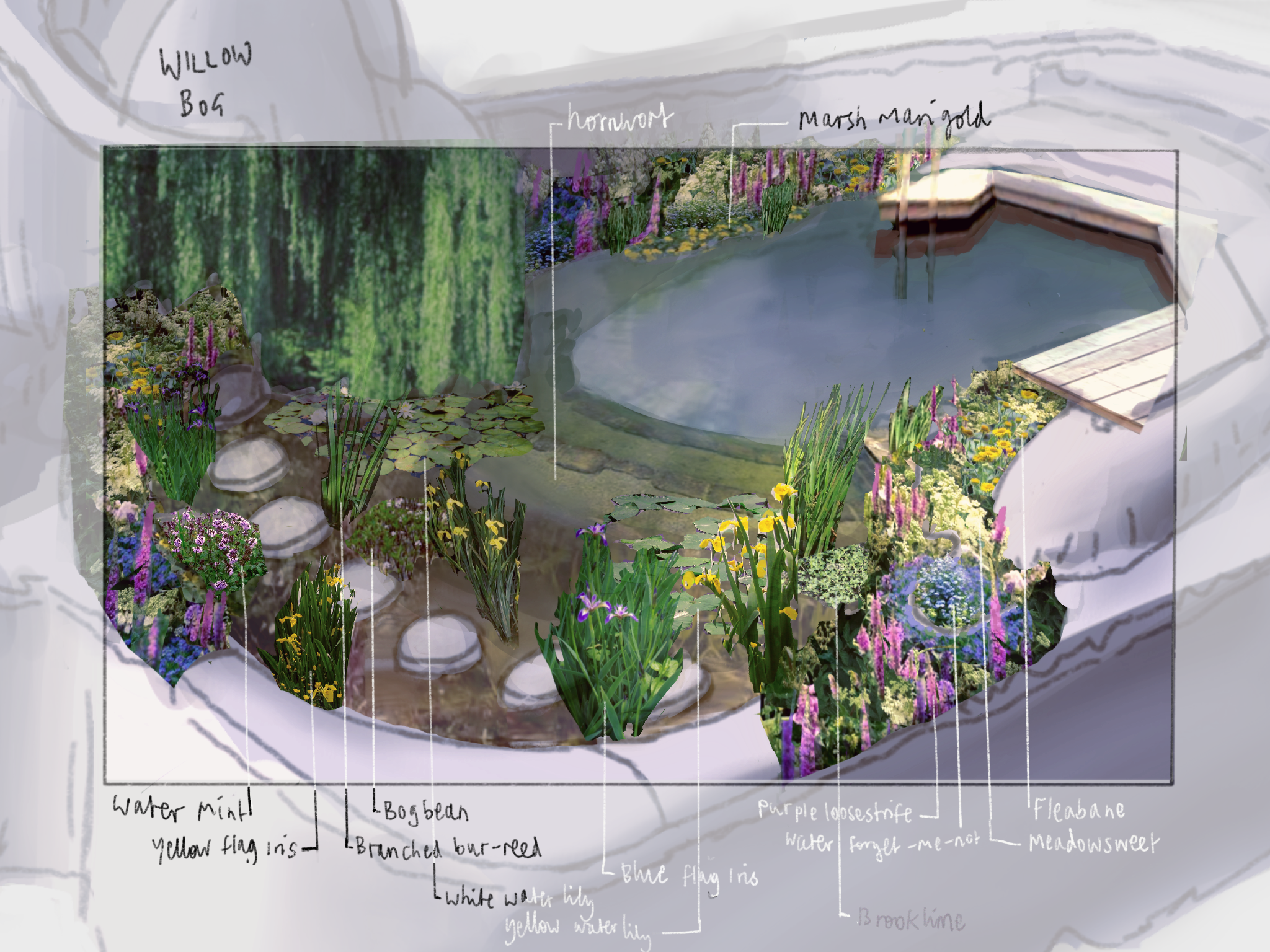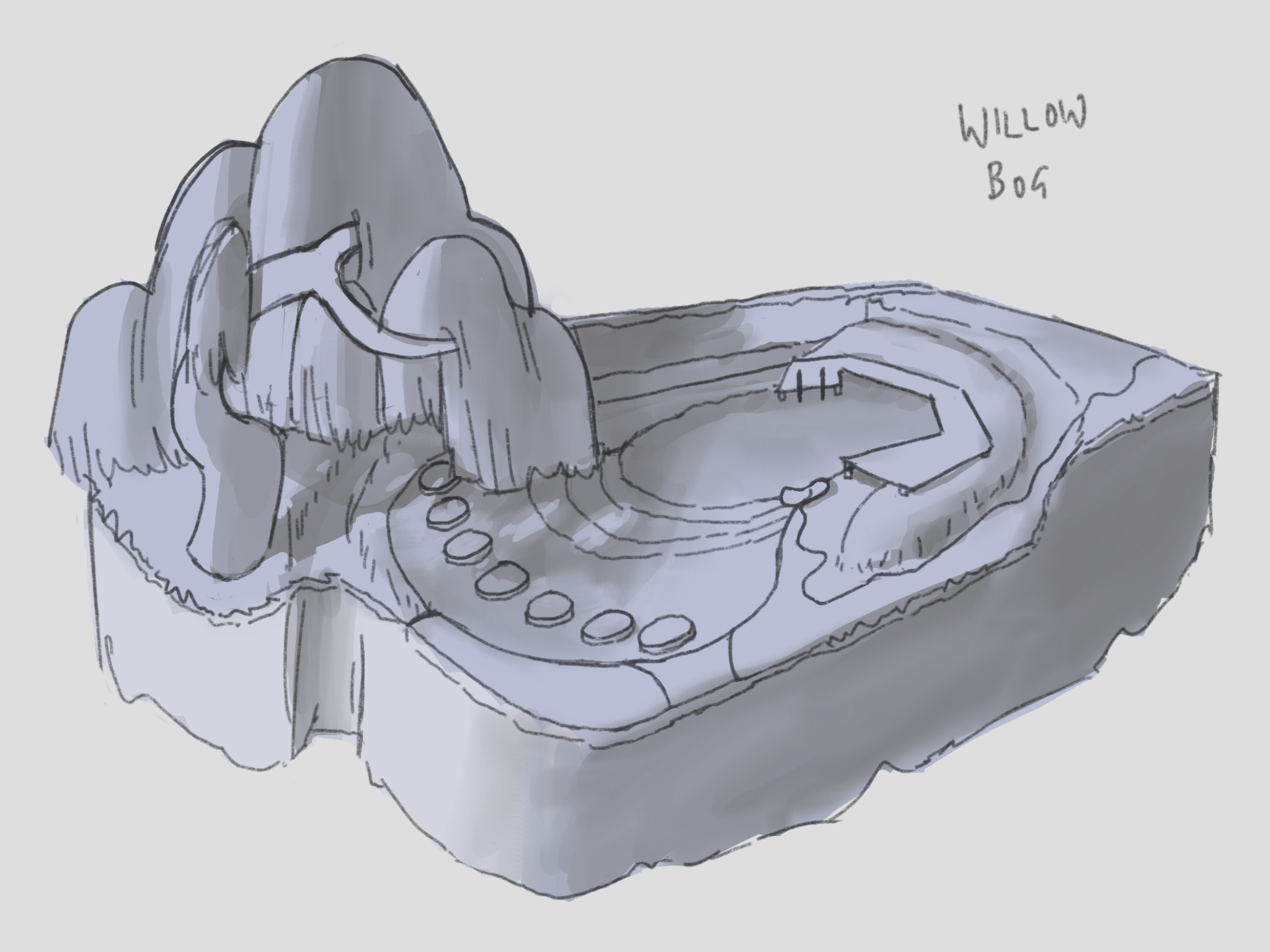Willow Bog: A Hidden Boggy Oasis
Willow Bog transforms a neglected, waterlogged corner of Willow End into a vibrant, naturalistic space inspired by the area’s history, the clients’ love for sustainability, and the enchanting allure of water. Nestled near the Willow Beck and shaded by a mature willow tree, this garden blends native planting, a rain garden, and a tranquil natural swimming pool. The result is a lush sanctuary where water, wildlife, and folklore converge.
Design Process
1. Client Brief
The client wanted to revitalise a boggy, irregularly shaped plot into a space that:
Supports biodiversity and wildlife, including frogs, dragonflies, and pollinators.
Incorporates sustainable, low-maintenance solutions that reflect their love for nature.
Celebrates the area’s folklore and history, blending rustic charm with native planting.
2. Site Survey
The area slopes gently toward an old stone wall, where water naturally gathers after rain. Shaded in part by a mature willow tree, the space enjoys dappled morning light and sunnier afternoons, creating microclimates ideal for diverse planting. Soil tests revealed rich, heavy clay loam with slight acidity, perfect for bog and riparian species.
3. History & Story
Willow End’s grounds were once part of a thriving orchard owned by the village’s local healer, a woman renowned for her knowledge of herbs and folklore. The orchard fell into neglect after her passing over 50 years ago, and the area was gradually reclaimed by nature. The Wilkinsons purchased Willow End three years ago, drawn to its rustic charm and the mysterious history attached to it. However, they have struggled to make the best use of this particular plot, unsure how to transform it from an eyesore into a functional and beautiful part of their home. The garden’s name, Willow Bog, pays homage to this legacy and the area’s natural characteristics.
4. Research
Key research areas included:
Langford Lakes Visit: A research trip to Langford Lakes provided inspiration for riparian planting and habitat creation. A pond I named Silver Pond influenced the kidney-bean shape of the swimming pool, chosen for its organic flow. Observations included water clarity, planting zones, and wildlife integration.
Natural Swimming Pool Construction: These pools are chemical-free and divided into two main zones: the swimming zone, which is free of plants and wildlife, and the regeneration zone, which uses aquatic plants and natural filtration systems to clean and oxygenate the water. Both zones are divided by a low wall of natural stone to ensure water clarity, and there is a pump to ensure water circulation.
Flow Forms: Sculpted water features designed to mimic natural water movements, creating oxygenation and enhancing water quality. They add a functional yet artistic touch to water management systems.
Willow Tree: The weeping willow is prized for its beauty and adaptability. Thriving in wet conditions, its fibrous root system prevents erosion while absorbing excess water. Symbolically, it represents resilience, renewal, and flexibility in folklore.
Desire Lines & Leading Lines: Understanding natural movement patterns informed the placement of features. The sandstone stepping stones through the shallow zone lead directly to the orchard gate, encouraging a journey through nature. Leading lines from the bench invite exploration of either the pool or the orchard, balancing immersion with discovery.
5. Concepts & Ideas
Natural Swimming Pool: A kidney-shaped pool blends seamlessly into the landscape, with planting zones designed for both ecological function and human use.
Terraced Garden & Stream: Sloped terraces drain water into a stream, which cascades gently into the pool via a flow form.
Stepping Stones Through Water: Sandstone stepping stones (salvaged from the old orchard wall) lead through the shallow zone of the pool to the orchard gate, immersing visitors in the experience of the space.
Folklore-Inspired Elements: Features like frog habitats and the willow’s prominent placement celebrate the land’s history and myths.
6. Final Design & Plant List
The planting scheme incorporates zones to maximise biodiversity and year-round interest:
Bankside Zone (0–2 cm): Marsh Marigold, Water Forget-Me-Not, Purple Loosestrife, and Meadowsweet attract pollinators and provide vibrant colour.
Shallow Marginal Zone (20–40 cm): Water Mint, Yellow Flag Iris, and Bogbean provide cover and breeding sites for amphibians.
Deep/Submerged Zone (40–60 cm): White and Yellow Water Lilies offer floating platforms for dragonflies, while Hornwort oxygenates the water.
Challenges & Growth
This project challenged my understanding of riparian planting and sustainable water management. Researching the construction of natural swimming pools deepened my ecological design skills, while the use of desire lines and leading lines enhanced my ability to balance aesthetics with functionality. Incorporating folklore into the layout strengthened my approach to blending narrative with design.
Reflections
Willow Bog embodies the three principles of my design philosophy:
Harmonious & Ecological Connection: Native plants, wildlife habitats, and sustainable practices restore balance to the space.
Timeless, Purposeful Beauty: A flowing pool, terraced gardens, and layered textures create lasting charm.
Inspired by Wonder & Story: Folklore elements, the willow tree, and thoughtfully placed features transform the space into a sanctuary of history and nature.
This project celebrates the transformative power of water and the enduring magic of nature.

